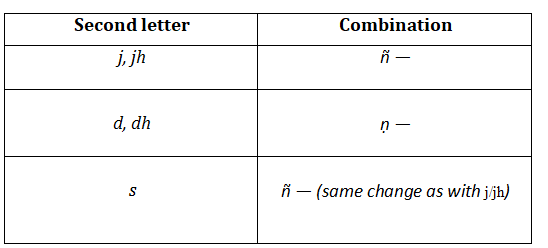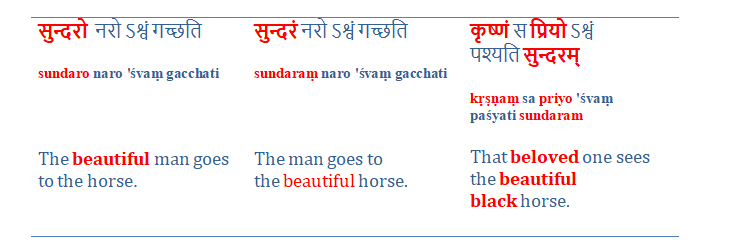Adjectives are the words that agree to the noun. They are descriptive words which describe the noun.
- The adjectives unlike in English do not appear after the noun, in fact, they appear before the noun.
- In Sanskrit, more than one adjective can be used to describe a single word. For instance, in example no. 3 from your right has two adjectives “Priya” which means dear or beloved and “Krsna” which means black.
- The adjectives are independent of noun
-n sandhi
Students of Sanskrit, while learning the Sanskrit language, have to memorize a number of rules for each grammatical concept. One such rule is regarding the use of sandhi. Sandhis are difficult to grasp as they have extensive use of rules. However, to simplify it we need to learn just one simple rule.
An – s sound cannot be placed between two voiced consonants.
Changes to –s sound
The sound of the consonant changes from “s” to “ns” sound. This tells us about how consonants work. The sound becomes nasalized. Nasalizing the sound is an important part of Vedic literature.
Change in point of pronunciation
The –s sound of –ns is removed since it appears in between the two consonants, it is left only with –n. which tells us an important fact about consonants, i.e.
‘They will change their sounds to match their surroundings’
Here are some few examples of it
Change to –l nasal
It is a very interesting change that we are going to study
One of the peculiarities of the Sanskrit language is that non-nasal sounds can be nasalized; such nasalized sounds can be easily found in Vedic literature. But, however, in today’s Sanskrit language which you can refer to as the modern Sanskrit literature has very less use of nasalized sounds.
In order to blend with the l sound, n becomes an l sound itself. But however, n is a nasal sound originally, it retains its nasal quality to become a nasal l.
Here, there is no change. The “s” of the *-ns ending cannot easily blend with the sounds that follow it, so it is dropped entirely. Since external sandhi changes do not happen twice in the same spot — as we see in examples like te icchati or naraḥ icchati — n does not change further.







